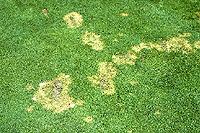Superphylum Heterokonta Order Pythiales | Scientific name Pythium ultimum Rank Species | |
 | ||
Similar Pythium, Pythium aphanidermatum, Pythium irregulare, Oomycete, Rhizoctonia | ||
Textbook on fungus pythium ultimum test 1
Pythium ultimum is a plant pathogen. It causes the damping-off and root rot diseases of hundreds of diverse plant hosts including corn, soybean, potato, wheat, fir, and many ornamental species. P. ultimum belongs to the peronosporalean lineage of oomycetes, along with other important plant pathogens such as Phytophthora spp. and many genera of downy mildews. Py. ultimum is a frequent inhabitant of fields, freshwater ponds, and decomposing vegetation in most areas of the world. Contributing to the widespread distribution and persistence of Py. ultimum is its ability to grow saprotrophically in soil and plant residue. This trait is also exhibited by most Pythium spp. but not by the related Phytophthora spp., which can only colonize living plant hosts.
Contents
- Textbook on fungus pythium ultimum test 1
- Textbook on fungus pythium ultimum test 2
- Pathology and disease management
- Genetics
- References
Textbook on fungus pythium ultimum test 2
Pathology and disease management
Infections of seeds and roots are initiated by both the mycelia and spores of Py. ultimum. Two spore types are made, depending on the strain. Py. ultimum is a species complex that includes var. ultimum and var. sporangiiferum. The major distinguishing feature is that sporangia and zoospores (swimming spores) are produced only rarely by Py. ultimum var. ultimum. Both species make oospores, which are thick-walled structures produced by sexual recombination. Both species are self-fertile (homothallic), which means that a single strain can mate with itself. In addition to oospores, Py. ultimum var. ultimum also makes hyphal swellings which germinate in a manner resembling sporangia to form plant-infecting hyphae. One important ecological difference between the different types of spores is that sporangia and zoospores are short-lived, while the thick-walled oospores can persist for years within soil, surviving even winter freezes. Mycelia and oospores in soil can infect seeds or roots. This leads to wilting, reduced yield, and ultimately plant death. Common signs of a Pythium infection include stunting of the plants, brown coloration of root-tips, and wilting of the plant during the warm part of the day. Management of disease is challenging but focuses on sanitation, fungicides, and biological control. Fungicides include mefenoxam, thiadiazole, etridiazole, propamocarb, dimethomorph, and phosphonates. Biological control agents include the bacteria Bacillus subtilis, Streptomyces griseoviridis, and the fungi Candida oleophila, Gliocladium catenulatum, Trichoderma harziamum, and Trichoderma virens. Effective resistance in the plant host is generally not available. Sanitation is very important since the pathogen can be easily introduced into pasteurized soil or even soil-free potting mixes on dirty tools or pots. Especially in greenhouses, fungus gnats may also help move the pathogen from place to place.
Genetics
The genomes of both Py. ultimum var. ultimum and Py. ultimum var. sporangiiferum have been sequenced. Analysis of the genomes suggest that the two species encode 15,290 and 14,086 proteins, respectively.
